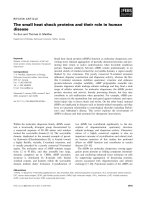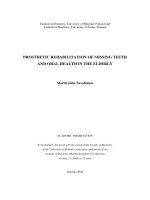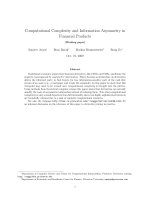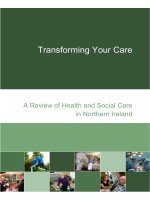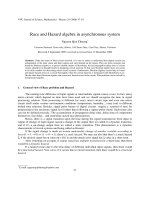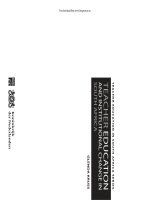Patent Foramen Ovale and Cryptogenic Stroke in Older Patients pptx
Bạn đang xem bản rút gọn của tài liệu. Xem và tải ngay bản đầy đủ của tài liệu tại đây (231.3 KB, 8 trang )
Patent Foramen Ovale and
Cryptogenic Stroke in Older
Patients
original article
T h e
ne w e ngl a nd j o u r n a l o f m e d icine
n engl j med 357;22 www.nejm.org november 29, 2007
2262
Patent Foramen Ovale and Cryptogenic
Stroke in Older Patients
Michael Handke, M.D., Andreas Harloff, M.D., Manfred Olschewski, M.Sc.,
Andreas Hetzel, M.D., and Annette Geibel, M.D.
From the Departments of Cardiology and
Angiology (M.H., A.G.), Neurology and
Neurophysiology (A. Harloff, A. Hetzel),
and Medical Biometry and Statistics (M.O.),
University Hospital Freiburg, Freiburg, Ger-
many. Address reprint requests to Dr.
Handke at the Department of Cardiology,
University Hospital Basel, Petersgraben 4,
4031 Basel, Switzerland, or at handkem@
uhbs.ch.
Drs. Handke and Harloff contributed equal-
ly to this article.
N Engl J Med 2007;357:2262-8.
Copyright © 2007 Massachusetts Medical Society.
A b s t r a c t
BACKGROUND
Studies to date have shown an association between the presence of patent foramen
ovale and cryptogenic stroke in patients younger than 55 years of age. This associa-
tion has not been established in patients 55 years of age or older.
METHODS
We prospectively examined 503 consecutive patients who had had a stroke, and we
compared the 227 patients with cryptogenic stroke and the 276 control patients with
stroke of known cause. We examined the prevalences of patent foramen ovale and
of patent foramen ovale with concomitant atrial septal aneurysm in all patients, using
transesophageal echocardiography. We also compared data for the 131 younger
patients (<55 years of age) and those for the 372 older patients (≥55 years of age).
RESULTS
The prevalence of patent foramen ovale was significantly greater among patients
with cryptogenic stroke than among those with stroke of known cause, for both
younger patients (43.9% vs. 14.3%; odds ratio, 4.70; 95% confidence interval [CI],
1.89 to 11.68; P<0.001) and older patients (28.3% vs. 11.9%; odds ratio, 2.92; 95% CI,
1.70 to 5.01; P<0.001). Even stronger was the association between the presence of
patent foramen ovale with concomitant atrial septal aneurysm and cryptogenic
stroke, as compared with stroke of known cause, among both younger patients
(13.4% vs. 2.0%; odds ratio, 7.36; 95% CI, 1.01 to 326.60; P = 0.049) and older pa-
tients (15.2% vs. 4.4%; odds ratio, 3.88; 95% CI, 1.78 to 8.46; P<0.001). Multivariate
analysis adjusted for age, plaque thickness, and presence or absence of coronary
artery disease and hypertension showed that the presence of patent foramen ovale
was independently associated with cryptogenic stroke in both the younger group
(odds ratio, 3.70; 95% CI, 1.42 to 9.65; P = 0.008) and the older group (odds ratio, 3.00;
95% CI, 1.73 to 5.23; P<0.001).
CONCLUSIONS
There is an association between the presence of patent foramen ovale and crypto-
genic stroke in both older patients and younger patients. These data suggest that
paradoxical embolism is a cause of stroke in both age groups.
Downloaded from www.nejm.org on February 18, 2008 . Copyright © 2007 Massachusetts Medical Society. All rights reserved.
Patent For amen Ova le and Cryp togenic Stroke in Older Patients
n engl j med 357;22 www.nejm.org november 29, 2007
2263
T
he cause of stroke remains uniden-
tified by routine diagnostic testing in about
40% of patients.
1
One potential cause of
embolic stroke is a patent foramen ovale, which
enables right-to-left intracardiac shunting. The
foramen ovale remains open in about one fourth
of the general population. The prevalence decreas-
es gradually with increasing age, from 34% dur-
ing the first three decades to 20% during the
ninth decade.
2
An association between the presence of pat-
ent foramen ovale and cryptogenic stroke has
been reported; however, the study populations
consisted primarily of younger patients.
3-6
Only
a few studies have included older patients.
7-9
A
meta-analysis showed that the presence of patent
foramen ovale in patients younger than 55 years
of age is significantly associated with cryptogenic
stroke, but the relationship has remained uncon-
firmed in patients 55 years of age or older.
10
Proof of a significant relationship would have
implications for diagnostic and therapeutic man-
agement.
The objectives of our study were to clarify
whether there is a significant association between
the presence of patent foramen ovale and crypto-
genic stroke in patients 55 years of age or older
and to compare the findings with those for
younger patients. Our study population included
all consecutive patients 18 to 85 years of age who
were admitted to our stroke unit or our neuro-
logic intensive care unit. We examined all patients
for the presence or absence of patent foramen
ovale, using transesophageal echocardiography.
Me t hods
Study Population
A total of 596 consecutive patients admitted to
our stroke unit or neurologic intensive care unit
fulfilled the inclusion criteria of an age of 18 to
85 years and the presence of suspected acute brain
ischemia. These patients were enrolled in the
study during the 16-month period between Janu-
ary 2001 and April 2002. Written informed con-
sent was obtained from each patient or, if the
patient was incapable of providing consent, from
the patient’s relatives. The study was approved by
the local ethics committee.
Thirty-seven patients were excluded from analy-
ses because transesophageal echocardiography
could not be performed: 10 were too ill to un-
dergo the procedure, 10 were transferred to an-
other clinic or died before the procedure could be
performed, 14 had an uncontrollable gag reflex
or gastrointestinal tract obstruction that preclud-
ed our performing the procedure, and 3 had un-
dergone the procedure in another clinic but the
method of data acquisition was inconsistent with
our protocol. An additional 24 patients declined
transesophageal echocardiography. Another 32 pa-
tients were excluded from analyses because their
diagnosis on discharge was other than brain ische-
mia. Our analyses focused on the remaining 503
patients.
The following routine diagnostic tests were
performed in all patients: cranial computed to-
mography, magnetic resonance imaging (MRI) of
the brain, or both; and duplex sonography of the
extracranial and intracranial arteries with a 4- to
7-MHz linear-array scanner (model ATL HDI
5000/3500, Advanced Technology Laboratories).
The degree of stenosis of the internal carotid ar-
tery was defined according to the European Carot-
id Surgery Trial protocol.
11
Angiographic imag-
ing of the intracranial and vertebrobasilar arteries
was performed in 231 patients (45.9%), by means
of time-of-flight angiography in patients who
underwent MRI or by means of digital subtrac-
tion angiography before intraarterial thromboly-
sis therapy in the remaining patients. Angiogra-
phy was not performed in 272 patients (54.1%).
All patients underwent transthoracic echocardiog-
raphy and electrocardiography. In patients with
suspected paroxysmal atrial fibrillation (those
with palpitations or a history of atrial fibrillation)
or ambiguous results of routine diagnostic tests,
we also performed 24-hour Holter monitoring.
Before transesophageal echocardiography was
performed, we classified the cause of infarction
according to the modified Trial of Org 10172 in
Acute Stroke Treatment (TOAST) criteria.
12
The
classification was done in advance to make pos-
sible a comparison of our data and those from
earlier studies of the role of patent foramen ovale
in stroke.
10
The TOAST classification subdivides
the cause of stroke into five subtypes, on the ba-
sis of clinical features and the results of diagnos-
tic tests: large-artery atherosclerosis, cardioembo-
lism, small-vessel occlusion, stroke of other known
cause, and stroke of unknown cause. The pa-
tients with stroke whose cause was classified as
one of the four known-cause subtypes were as-
signed to the known-cause group in our study.
We deviated from the original TOAST criteria by
assigning patients with two or more causes of
Downloaded from www.nejm.org on February 18, 2008 . Copyright © 2007 Massachusetts Medical Society. All rights reserved.
T h e n e w e ngl a n d j o u r n a l o f m e d icine
n engl j med 357;22 www.nejm.org november 29, 2007
2264
stroke to the known-cause group. Patients with
stroke of causes that were unknown despite ex-
tensive routine diagnostic testing before trans-
esophageal echocardiography were assigned to
our cryptogenic-stroke group.
Echocardiographic Examinations
An ultrasonography system (ATL HDI 3500) was
used for transthoracic examinations (with a 2-MHz
transducer) and transesophageal examinations
(with a 5-MHz transducer). Routine transthoracic
echocardiography of the heart was performed in
each patient. Within a median of 2 days after
stroke onset (mean ±SD, 3±2), all patients under-
went transesophageal echocardiography. A con-
trast agent (oxypolygelatin [Gelifundol, Biotest])
was injected while the patient was at rest and
while a Valsalva maneuver was performed. Patent
foramen ovale was diagnosed when microbub-
bles were detected in the left atrium within four
cycles after right-atrial opacification. Atrial sep-
tal aneurysm was diagnosed when the excur-
sion of an abnormally redundant and mobile atrial
septum was over 10 mm.
13
The ascending aorta
and the aortic arch, including the outlet of the
left subclavian artery, were examined for aortic
plaques. The thickest plaque was considered for
classification.
14
Statistical Analysis
Data are presented as means ±SD for continuous
variables and as absolute numbers and relative
percentages for categorical variables. Group com-
parisons were performed by means of the Wil-
coxon rank-sum test for continuous variables and
Fisher’s exact test for categorical variables. Uni-
variate and multivariate logistic-regression analy-
ses were used to estimate the unadjusted and ad-
justed odds ratios and the corresponding 95%
confidence intervals. The characteristics that af-
fected the univariate analysis were included in the
multivariable models: age, plaque thickness, pres-
ence or absence of coronary artery disease, and
presence or absence of hypertension. All statisti-
cal tests were two-sided, and P values of less than
0.05 were considered to indicate statistical signifi-
cance. All analyses were performed with the SAS
statistical package (version 8.2).
R e s ults
Baseline Characteristics
The overall age range of the patients was 20 to 84
years (mean, 62.2±13.1). Of the 503 patients, 131
(26.0%) were younger than 55 years of age (mean,
45.3±8.3), and 372 (74.0%) were 55 years of age
or older (mean, 68.0±7.0). The cause of stroke
could be identified by means of routine diagnos-
tic testing in 276 patients (54.9%). The stroke was
classified as cryptogenic in the remaining 227
patients (45.1%), including 82 of the 131 patients
younger than 55 years of age (62.6%) and 145 of
the 372 patients 55 years of age or older (39.0%).
As compared with the patients with stroke of
known cause, the patients with cryptogenic stroke
were on average 6 years younger and more of them
had patent foramen ovale with or without a con-
comitant atrial septal aneurysm (
Table 1
). On the
Table 1. Baseline Characteristics of Patients with Cryptogenic Stroke or with Stroke of Known Cause.*
Characteristic
Cryptogenic Stroke
(N = 227)
Stroke of Known Cause
(N = 276) P Value
Age — yr 58.2±13.9 64.5±10.4 <0.001
Female sex — no. (%) 94 (41.4) 97 (35.1) 0.17
PFO — no. (%) 77 (33.9) 34 (12.3) <0.001
PFO–ASA — no. (%) 33 (14.5) 11 (4.0) <0.001
Hypertension — no. (%) 143 (63.0) 222 (80.4) <0.001
Diabetes — no. (%) 48 (21.1) 74 (26.8) 0.15
Hyperlipidemia — no. (%) 81 (35.7) 111 (40.2) 0.31
History of smoking — no. (%) 68 (30.0) 76 (27.5) 0.55
Coronary artery disease — no. (%) 41 (18.1) 82 (29.7) 0.003
Peripheral artery disease — no. (%) 12 (5.3) 20 (7.2) 0.46
Aortic plaque — mm 2.72±1.83 3.06±1.55 <0.001
* Plus–minus values are means ±SD. PFO denotes patent foramen ovale, and ASA atrial septum aneurysm.
Downloaded from www.nejm.org on February 18, 2008 . Copyright © 2007 Massachusetts Medical Society. All rights reserved.
Patent For amen Ova le and Cryp togenic Stroke in Older Patients
n engl j med 357;22 www.nejm.org november 29, 2007
2265
other hand, patients with cryptogenic stroke had
a lower prevalence of coronary artery disease or
hypertension and slightly thinner aortic plaques
than patients with stroke of known cause. There
were no significant differences between the two
groups with regard to sex or the presence or
absence of diabetes, hyperlipidemia, history of
smoking, or peripheral artery disease.
Association between Patent Foramen Ovale
and Cryptogenic Stroke
The prevalence of patent foramen ovale was sig-
nificantly greater among patients with cryptogen-
ic stroke than among patients with stroke of
known cause. This held true both for patients
younger than 55 years of age (43.9% vs. 14.3%,
P<0.001) and for patients 55 years of age or older
(28.3% vs. 11.9%, P<0.001) (Fig. 1A). The preva-
lence of patent foramen ovale with concomitant
atrial septal aneurysm was also greater among
patients with cryptogenic stroke than among
those with stroke of known cause, both in the
younger group (13.4% vs. 2.0%, P = 0.03) and in
the older group (15.2% vs. 4.4%, P<0.001) (Fig. 1B).
In the unadjusted univariate analysis, the odds
ratios for patients younger than 55 years of age
with cryptogenic stroke, as compared with stroke
of known cause, were 4.70 (95% confidence in-
terval [CI], 1.89 to 11.68; P<0.001) for the pres-
ence of patent foramen ovale and 7.36 (95% CI,
1.01 to 326.60; P = 0.049) for the presence of pat-
ent foramen ovale with concomitant atrial septal
aneurysm. Among patients 55 years of age or
older, the odds ratios were smaller: 2.92 (95% CI,
1.70 to 5.01; P<0.001) for the presence of patent
foramen ovale and 3.88 (95% CI, 1.78 to 8.46;
P<0.001) for the presence of patent foramen ovale
with concomitant atrial septal aneurysm. In the
multivariate analysis, the presence of patent fora-
men ovale was independently associated with
cryptogenic stroke (Fig. 2), both in the overall
study population and in the younger and older
groups. In contrast to the unadjusted odds ratios
from the univariate analysis, the adjusted odds
ratios from the multivariate analysis showed only
a slight difference in the prevalence of patent fora-
men ovale among patients with cryptogenic stroke,
as compared with stroke of known cause, in the
younger group (odds ratio, 3.70; P = 0.008) and the
older group (odds ratio, 3.00; P<0.001).
Among patients 55 years of age or older with
cryptogenic stroke, atherosclerotic plaque thick-
ness was significantly less in patients with patent
foramen ovale (2.78±1.56 mm) and in those with
patent foramen ovale with concomitant atrial
septal aneurysm (2.64±1.36 mm) than in patients
without patent foramen ovale (3.65±1.95 mm)
(Fig. 3). These three subgroups did not differ
significantly with respect to mean age (67.8±8.0
years, 68.6±8.0 years, and 67.9±7.0 years, respec-
tively; P = 0.81). Among patients 55 years of age or
older, the multivariate analysis also showed a
nearly significant relationship between the thick-
ness of the aortic plaque and the risk of crypto-
genic stroke (odds ratio for patients with crypto-
genic stroke vs. stroke of known cause, 1.15 per
1-mm increase in plaque thickness; 95% CI, 1.00
to 1.31; P = 0.05).
Discus s ion
We found an association between the presence of
patent foramen ovale and cryptogenic stroke, not
only in patients younger than 55 years of age but
also in those 55 years of age or older. The rela-
tionship between the presence of patent foramen
ovale and cryptogenic stroke was even more pro-
Patent Foramen Ovale
Patent Foramen Ovale with Atrial Septal Aneurysm
16p6
Percent of Patients
50
40
30
10
20
0
≥55 Yr<55 Yr
B
A
P<0.001 P<0.001
AUTHOR:
FIGURE:
JOB: ISSUE:
4-C
H/T
RETAKE
SIZE
ICM
CASE
Line
H/T
Combo
Revised
AUTHOR, PLEASE NOTE:
Figure has been redrawn and type has been reset.
Please check carefully.
REG F
Enon
1st
2nd
3rd
Handke
1 of 3
10-18-07
ARTIST: ts
35716
Cryptogenic Known cause
Percent of Patients
25
20
15
5
10
0
≥55 Yr<55 Yr
P=0.03 P<0.001
Cryptogenic Known cause
Figure 1. Prevalences of Patent Foramen Ovale (PFO)
and PFO with Concomitant Atrial Septal Aneurysm
among Patients with Cryptogenic Stroke and Those
with Stroke of Known Cause, According to Age Group.
Downloaded from www.nejm.org on February 18, 2008 . Copyright © 2007 Massachusetts Medical Society. All rights reserved.
T h e n e w e ngl a n d j o u r n a l o f m e d icine
n engl j med 357;22 www.nejm.org november 29, 2007
2266
nounced among patients who had concomitant
atrial septal aneurysm. Moreover, multivariate
analysis showed that the presence of a patent fo-
ramen ovale was independently associated with
cryptogenic stroke in both age groups.
Previous studies have been limited by selection
bias, with older patients undergoing transesoph-
ageal echocardiography less often than younger
patients.
10
In our study, transesophageal echo-
cardiography was performed for all patients. The
prevalence of cryptogenic stroke in our study was
relatively high, at 45%. However, we classified
the cause of stroke before transesophageal echo-
cardiography was performed, as was done in a
recently published study.
15
Two studies that re-
ported prevalences of cryptogenic stroke lower
than those in our study used available data from
transesophageal echocardiography to classify the
cause of stroke.
16,17
We may have slightly overesti-
mated the prevalence of cryptogenic stroke, be-
cause magnetic resonance angiography or digital
subtraction angiography was performed in only
about half the patients. As a result, some patients
with intracranial large-artery atherosclerosis may
have been erroneously assigned to the crypto-
genic-stroke group.
It has long been debated whether the presence
of patent foramen ovale actually does play a caus-
al role in stroke or whether there is only a non-
causal statistical relationship. However, there is
considerable evidence
18
that a patent foramen
ovale can cause ischemic stroke, by means of
paradoxical embolism. A positive relationship has
been shown between the size of the shunt and
the risk of stroke,
19
patients with a residual shunt
after occlusion of the patent foramen ovale have an
increased rate of recurrence of stroke,
20
the rate
of stroke is increased among patients with pul-
monary embolism and a patent foramen ovale,
21
and the migration of a thrombus through the pat-
ent foramen ovale can be directly visualized re-
peatedly,
22
even in very elderly patients.
23,24
The
relationship is still controversial with respect to
older patients,
25
because the available data are
contradictory and are based on studies that used
different diagnostic tests.
7-9
In a study involving
transthoracic echocardiography, Di Tullio et al.
reported an increased prevalence of patent fora-
men ovale in all age groups with cryptogenic
stroke.
7
In one study using transesophageal echo-
cardiography, and another using transcranial Dop-
pler ultrasonography, for detection of right-to-left
shunting after administration of contrast agent,
there were no significant associations between the
presence of patent foramen ovale and cryptogenic
stroke.
8,9
Data from these studies were insuffi-
cient to draw a conclusion for older patients with
cryptogenic stroke.
10
In addition to the significant association found
in our study, additional considerations provide
support for the hypothesis that patent foramen
ovale plays a role in stroke in older patients. With
increasing age, there is an increasing potential
for paradoxical embolism,
26
since the incidence
of venous thromboembolism increases exponen-
tially with increasing age.
27
The combination of
more frequent formation of thromboembolic ma-
terial and hemodynamic changes promoting right-
to-left shunting could contribute to an increased
probability of paradoxical embolism in older pa-
tients.
28
A recent retrospective analysis showed
that the presence of patent foramen ovale increas-
es the risk of adverse events in older patients with
cryptogenic stroke who are receiving aspirin or
warfarin, but not in younger patients.
28
In addi-
tion, the diameter of the patent foramen ovale in-
creases with age,
2
and this could make older pa-
tients more susceptible to paradoxical embolism.
7
33p9
−1.0 1.0 3.0 9.0 11.0
Positive AssociationNegative Association
All patients
Patients <55 yr
Patients ≥55 yr
Stroke of Known Cause
(N=276) Adjusted Odds Ratio (95% CI)Group
3.12 (1.98–5.10)
3.00 (1.73–5.23)
3.70 (1.42–9.65)
34/276
7/49
27/227
Cryptogenic Stroke
(N=227)
77/227
36/82
41/145
5.0 7.0
AUTHOR:
FIGURE:
JOB:
4-C
H/T
RETAKE
SIZE
ICM
CASE
Line
H/T
Combo
Revised
AUTHOR, PLEASE NOTE:
Figure has been redrawn and type has been reset.
Please check carefully.
REG F
Enon
1st
2nd
3rd
Handke
2 of 3
10-18-07
ARTIST: ts
35716 ISSUE:
Figure 2. Odds Ratios for the Presence of Patent Foramen Ovale among Patients with Cryptogenic Stroke, as Compared
with Those with Stroke of Known Cause.
Odds ratios were adjusted for age, plaque thickness, presence or absence of coronary artery disease, and presence
or absence of hypertension.
Downloaded from www.nejm.org on February 18, 2008 . Copyright © 2007 Massachusetts Medical Society. All rights reserved.
Patent For amen Ova le and Cryp togenic Stroke in Older Patients
n engl j med 357;22 www.nejm.org november 29, 2007
2267
The question of causality between the presence
of patent foramen ovale and stroke is, however,
more difficult to answer with regard to older pa-
tients than with regard to younger patients, since
older patients frequently have additional potential
sources of emboli, such as atherosclerosis of the
aorta.
29
This lends particular importance to the
observation in our study that older patients with
cryptogenic stroke and patent foramen ovale had
significantly less severe atherosclerosis of the
aortic arch than did patients without patent fora-
men ovale. The probability that the ischemia in
the subgroup with patent foramen ovale is due to
embolism from the aortic arch is correspondingly
smaller, since the risk of embolism correlates
with plaque thickness.
29
Consistent with other reports, our study showed
a lower prevalence of patent foramen ovale in
older patients with cryptogenic stroke than in
younger patients.
15
In addition to the fact that
alternative causes should be taken into account
in older patients, it should be considered that
the prevalence of patent foramen ovale decreases
linearly with increasing age.
2
On the other hand,
the numbers of patients with patent foramen
ovale and concomitant atrial septal aneurysm
who were younger than 55 years of age and who
were 55 years of age or older were similar in both
the cryptogenic-stroke group (13.4% and 15.2%,
respectively) and the known-cause group (2.0%
and 4.4%, respectively). Di Tullio et al. reported a
low prevalence of patent foramen ovale with con-
comitant atrial septal aneurysm (1.7%) in the gen-
eral population.
30
In a study of patients 55 years
of age or younger, Mas et al. found that the pres-
ence of patent foramen ovale with concomitant
atrial septal aneurysm is associated with a high
risk of paradoxical embolism.
13
Our data suggest
that the presence of patent foramen ovale with
concomitant atrial septal aneurysm is a high-risk
characteristic in older patients as well.
In summary, our results show an association
between the presence of patent foramen ovale and
cryptogenic stroke in both patients younger than
55 years of age and those 55 years of age or older.
There are no clear guidelines based on random-
ized trials for therapy if patent foramen ovale is
present. There are several ongoing randomized
studies (Randomized Evaluation of Recurrent
Stroke Comparing PFO Closure to Established
Current Standard of Care Treatment [RESPECT]
trial, Evaluation of the STARFlex Septal Closure
System in Patients with a Stroke or TIA due to
the Possible Passage of Clot of Unknown Origin
through a Patent Foramen Ovale [CLOSURE-1],
and PC [Percutaneous Closure]-Trial: Patent Fo-
ramen Ovale and Cryptogenic Embolism); their
results may clarify the effectiveness of percuta-
neous closure as compared with medical therapy.
However, the patients in all three trials are 60
years of age or younger on enrollment, and stud-
ies that include older patients are needed to devel-
op diagnostic and therapeutic management strat-
egies for this large group of patients.
No potential conflict of interest relevant to this article was
reported.
16p6
AUTHOR:
FIGURE:
JOB: ISSUE:
4-C
H/T
RETAKE
SIZE
ICM
CASE
Line
H/T
Combo
Revised
AUTHOR, PLEASE NOTE:
Figure has been redrawn and type has been reset.
Please check carefully.
REG F
Enon
1st
2nd
3rd
Handke
3 of 3
10-18-07
ARTIST: ts
35716
5
Aortic Plaque (mm)
3
4
6
2
1
0
No PFO PFO PFO–ASA
P=0.01
P=0.009
Figure 3. Mean Thickness of Atherosclerotic Plaque
in Patients 55 Years of Age or Older with Cryptogenic
Stroke.
PFO denotes patent foramen ovale, and ASA atrial
septal aneurysm. I bars indicate standard deviations.
References
Sacco RL, Ellenberg JH, Mohr JP, et
al. Infarcts of undetermined cause: the
NINCDS Stroke Data Bank. Ann Neurol
1989;25:382-90.
Hagen PT, Scholz DG, Edwards WD.
Incidence and size of patent foramen ovale
during the first 10 decades of life: an au-
1.
2.
topsy study of 965 normal hearts. Mayo
Clin Proc 1984;59:17-20.
Lechat P, Mas JL, Lascault G, et al.
Prevalence of patent foramen ovale in pa-
tients with stroke. N Engl J Med 1988;
318:1148-52.
Webster MW, Chancellor AM, Smith
3.
4.
HJ, et al. Patent foramen ovale in young
stroke patients. Lancet 1988;2:11-2.
Cabanes L, Mas JL, Cohen A, et al.
Atrial septal aneurysm and patent for-
amen ovale as risk factors for crypto-
genic stroke in patients less than 55 years
of age: a study using transesophageal
5.
Downloaded from www.nejm.org on February 18, 2008 . Copyright © 2007 Massachusetts Medical Society. All rights reserved.
n engl j med 357;22 www.nejm.org november 29, 2007
2268
Patent For amen Ova le and Cryp togenic Stroke in Older Patients
echocardiography. Stroke 1993;24:1865-
73.
Job FP, Ringelstein EB, Grafen Y, et al.
Comparison of transcranial contrast Dop-
pler sonography and transesophageal con-
trast echocardiography for the detection
of patent foramen ovale in young stroke
patients. Am J Cardiol 1994;74:381-4.
Di Tullio M, Sacco RL, Gopal A, Mohr
JP, Homma S. Patent foramen ovale as a
risk factor for cryptogenic stroke. Ann
Intern Med 1992;117:461-5.
Jones EF, Calafiore P, Donnan GA,
Tonkin AM. Evidence that patent foramen
ovale is not a risk factor for cerebral ische-
mia in the elderly. Am J Cardiol 1994;74:
596-9.
Yeung M, Khan KA, Shuaib A. Trans-
cranial Doppler ultrasonography in the
detection of venous to arterial shunting in
acute stroke and transient ischaemic at-
tacks. J Neurol Neurosurg Psychiatry 1996;
61:445-9.
Overell JR, Bone I, Lees KR. Interatrial
septal abnormalities and stroke: a meta-
analysis of case-control studies. Neurol-
ogy 2000;55:1172-9.
MRC European Carotid Surgery Trial-
ists’ Collaborative Group. MRC European
Carotid Surgery Trial: interim results for
symptomatic patients with severe (70-99%)
or with mild (0-29%) carotid stenosis.
Lancet 1991;337:1235-43.
Adams HP Jr, Bendixen BH, Kappelle
LJ, et al. Classification of subtype of acute
ischemic stroke: definitions for use in a
multicenter clinical trial. Stroke 1993;24:
35-41.
Mas JL, Arquizan C, Lamy C, et al.
Recurrent cerebrovascular events associat-
ed with patent foramen ovale, atrial septal
aneurysm, or both. N Engl J Med 2001;
345:1740-6.
6.
7.
8.
9.
10.
11.
12.
13.
The French Study of Aortic Plaques in
Stroke Group. Atherosclerotic disease of
the aortic arch as a risk factor for recur-
rent ischemic stroke. N Engl J Med 1996;
334:1216-21.
De Castro S, Rasura M, Di Angelan-
tonio E, et al. Distribution of potential
sources of embolism in young and older
stroke patients: implications for recurrent
vascular events. J Cardiovasc Med (Hagers-
town) 2006;7:191-6.
Petty GW, Brown RD Jr, Whisnant JP,
Sicks JD, O’Fallon WM, Wiebers DO. Ische-
mic stroke subtypes: a population-based
study of incidence and risk factors. Stroke
1999;30:2513-6.
Kolominsky-Rabas PL, Weber M, Gefel-
ler O, Neundoerfer B, Heuschmann PU.
Epidemiology of ischemic stroke subtypes
according to TOAST criteria: incidence,
recurrence, and long-term survival in is-
chemic stroke subtypes: a population-
based study. Stroke 2001;32:2735-40.
Windecker S, Wahl A, Nedeltchev K, et
al. Comparison of medical treatment with
percutaneous closure of patent foramen
ovale in patients with cryptogenic stroke.
J Am Coll Cardiol 2004;44:750-8.
Stone DA, Godard J, Corretti MC, et al.
Patent foramen ovale: association between
the degree of shunt by contrast trans-
esophageal echocardiography and the risk
of future ischemic neurologic events. Am
Heart J 1996;131:158-61.
Wahl A, Meier B, Haxel B, et al. Prog-
nosis after percutaneous closure of patent
foramen ovale for paradoxical embolism.
Neurology 2001;57:1330-2.
Kasper W, Geibel A, Tiede N, Just H.
Patent foramen ovale in patients with hae-
modynamically significant pulmonary em-
bolism. Lancet 1992;340:561-4.
Kessel-Schaefer A, Lefkovits M, Zell-
14.
15.
16.
17.
18.
19.
20.
21.
22.
weger MJ, et al. Migrating thrombus
trapped in a patent foramen ovale. Circu-
lation 2001;103:1928.
Iwanaga T, Iguchi Y, Shibazaki K, In-
oue T, Kimura K. Paradoxical brain em-
bolism in an acute stroke. J Neurol Sci
2007;254:102-4.
Fraticelli A, Gambini C, Iannoni E,
Paciaroni E. Impending paradoxical em-
bolism through a patent foramen ovale in
an octogenarian with pulmonary embo-
lism: detection by transesophageal echo-
cardiography and successful treatment
by anticoagulation. Arch Gerontol Geriatr
1998;27:41-7.
Nomura E, Matsumoto M. Cerebral
infarction and patent foramen ovale (PFO)
in the elderly: is PFO the culprit or not?
Intern Med 2005;44:401-2.
Meier B. Patent foramen ovale, guilty
but only as a gang member and for a lesser
crime. J Am Coll Cardiol 2006;47:446-8.
Anderson FA Jr, Wheeler HB, Goldberg
RJ, et al. A population-based perspective
of the hospital incidence and case-fatality
rates of deep vein thrombosis and pulmo-
nary embolism: the Worcester DVT Study.
Arch Intern Med 1991;151:933-8.
Homma S, DiTullio MR, Sacco RL,
Sciacca RR, Mohr JP. Age as a determinant
of adverse events in medically treated cryp-
togenic stroke patients with patent fora-
men ovale. Stroke 2004;35:2145-9.
Amarenco P, Cohen A, Tzourio C, et al.
Atherosclerotic disease of the aortic arch
and the risk of ischemic stroke. N Engl J
Med 1994;331:1474-9.
Di Tullio MR, Sacco RL, Sciacca RR,
Jin Z, Homma S. Patent foramen ovale and
the risk of ischemic stroke in a multieth-
nic population. J Am Coll Cardiol 2007;49:
797-802.
Copyright © 2007 Massachusetts Medical Society.
23.
24.
25.
26.
27.
28.
29.
30.
receive
immediate
notification
when
a
journal
article
is
released
early
To be notified when an article is released early
on the Web and to receive the table of contents
of the Journal by e-mail every Wednesday evening,
sign up through our Web site at
www.nejm.org
Downloaded from www.nejm.org on February 18, 2008 . Copyright © 2007 Massachusetts Medical Society. All rights reserved.



